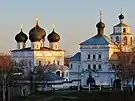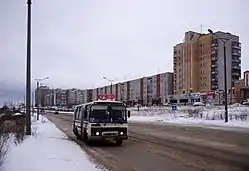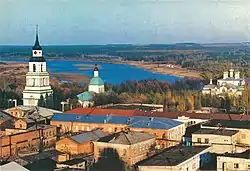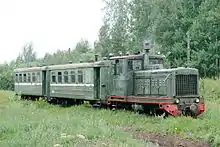Kirov Oblast
Kirov Oblast (Russian: Ки́ровская о́бласть, romanized: Kirovskaya oblast) is a federal subject of Russia (an oblast) located in Eastern Europe. Its administrative center is the city of Kirov. As of the 2010 census, the population is 1,341,312.[11]
Kirov Oblast | |
|---|---|
| Кировская область | |
 Flag  Coat of arms | |
.svg.png.webp) | |
| Coordinates: 58°46′N 49°50′E | |
| Country | Russia |
| Federal district | Volga[1] |
| Economic region | Volga-Vyatka[2] |
| Administrative center | Kirov[3] |
| Government | |
| • Body | Legislative Assembly[4] |
| • Governor[4] | Aleksandr Sokolov[5] |
| Area | |
| • Total | 120,374 km2 (46,477 sq mi) |
| • Rank | 30th |
| Population | |
| • Total | 1,153,680 |
| • Estimate (2018)[8] | 1,283,238 |
| • Rank | 41st |
| • Density | 9.6/km2 (25/sq mi) |
| • Urban | 77.8% |
| • Rural | 22.2% |
| Time zone | UTC+3 (MSK |
| ISO 3166 code | RU-KIR |
| License plates | 43 |
| OKTMO ID | 33000000 |
| Official languages | Russian[10] |
| Website | http://www.kirovreg.ru |
Geography
Natural resources
The basis of the natural resources are forest (mostly conifers), phosphate rock, peat, furs, water and land resources. There are widespread deposits of peat and non-metallic minerals: limestone, marl, clay, sand and gravel, as well as the extremely rare mineral volkonskoite. In recent decades, in the east of the area revealed a minor recoverable oil reserves and deposits of bentonite clays. In the area is the largest in Europe Vyatsko-Kama deposit of phosphate rock. The area is rich in mineral springs and therapeutic mud. On the territory of Kumyonsky District is famous resort town of federal significance Nizhneivkino, which on treatment and rest come to residents of the Kirov region and many regions of Russia.
Hydrography
The region has a total length of 19753 River 66.65 kilometers. Northern Uvaly two separate river basins – the Severodvinsk and the Volga. Much of the area is occupied by the Vyatka River basin, a tributary of the Kama River in Tatarstan. At Kama is only in the upper reaches. To large flowing within the area are also river mole and Tansy, Luza, Cobra, Cheptsa.
The total number of lakes in the area of 4.5 thousand ponds With the total number of closed water area of 5.5 million. The largest lakes are: Akshuben – 85 hectares, the Oryol – 63 hectares, Muserskoe – 32 hectares. The deepest area of the pond Lezhninskoe Lake – 36.6 m.
History
In the late 19th and early 20th centuries, Vyatka remained a place of exile for opponents of the tsarist regime, including many prominent revolutionary figures. In 1920, a number of small southern and eastern districts (volosti) and villages were shifted from Vyatka as a result of the formation of the Tatar Autonomous Soviet Socialist Republic and the Mari and Votskaya (now the Udmurt Republic) autonomous regions.
The territory did not escape the Russian Civil War and intervention of 1918-1921. Then in 1921-1922, it was hit by famine, followed by a typhus epidemic in late 1922. The death rate doubled during those years. The postwar period was accompanied by rebuilding of the province on the basis of the New Economic Policy (NEP), which consisted of free trade, entrepreneurship, and private sector stimulation. However, the basic principles of the NEP never really took hold in agriculture, where the only effect was to reduce all the peasants to the same level, or in industry.
The country's first office of the International Organization for Aid to Fighters of the Revolution (IOAR) began operations here in January 1923.
The administrative and territorial reforms of 1929 eliminated the old division of the country into provinces and districts (Uezd, Volost) and introduced a new system of division into regions, territories, and districts (raiony). Vyatka Province was abolished, and its territory became part of Nizhny Novgorod Oblast. The city of Vyatka became a district center.
On December 5, 1934, the Presidium of the All-Russian Central Executive Committee (VTsIK) passed a resolution renaming the city from Vyatka to Kirov, and Kirov Oblast was formed on December 7.[12] It included the Udmurt Autonomous Region, 37 districts (raiony) of Gorki Region (which had formerly been part of Vyatka Province), as well as Sapapulsky and Votkinsky districts of Sverdlovsk Region. Following the adoption of the new Constitution in 1936, Kirov Territory was transformed into Kirov Region and the Udmurt Autonomous Soviet Socialist Republic (ASSR) was separated from it..[12]
On 30 October 1997, Kirov, alongside Astrakhan, Murmansk, Ulyanovsk, and Yaroslavl, signed a power-sharing agreement with the government of Russia, granting it autonomy.[13] The agreement would be abolished on 24 January 2002.[14]
Administrative divisions
Kirov Oblast was formed on December 7, 1934. It is divided administratively into 39 districts, 6 cities under oblast jurisdiction, 13 town under district jurisdiction, 58 urban-type settlements, and 580 selsoviets.
Economy
Kirov Oblast is part of the Volga–Vyatka economic district located in the central part of European Russia in the Volga and Vyatka river basins. Its economic complex had already begun forming and developing before the Revolution, in large part because of the transfer points and trading posts located in Vyatka, which later led to the formation of large trading centers. Agriculture was the priority sector at first, but starting in 1940, there was an upsurge in development of an industrial complex, especially the engineering, metalworking, and chemical industries.[15]
Kirov Oblast is part of the Volga–Vyatka agricultural zone, where more than half of the area sown in grain is located in Kirov Oblast itself. Agricultural land occupies 27% of the region's territory. The most important grain crops are winter and spring wheat and rye. Barley and oats are grown for fodder. Increased specialization in the production of more promising fodder crops like winter rye, barley, oats that are most suited to the Oblast's climatic conditions is anticipated in the future. Potatoes are also extensively cultivated.[15]
Transportation
- The Dymnoye peat railway operates in Verkhnekamsky District
- The Gorokhovskoye peat railway operates in Kotelnichsky District
- The Otvorskoye peat railway operates in Kotelnichsky District
- The Pishchalskoye peat railway operates in Orichevsky District
- The Kobrinskaya narrow-gauge railway for hauling felled logs operates in Murashinsky District
- The Oparinskaya narrow-gauge railway for hauling felled logs operates in Oparinsky District
Politics
During the Soviet period, the high authority in the oblast was shared between three persons: The first secretary of the Kirov CPSU Committee (who in reality had the biggest authority), the chairman of the oblast Soviet (legislative power), and the Chairman of the oblast Executive Committee (executive power). Since 1991, CPSU lost all the power, and the head of the Oblast administration, and eventually the governor was appointed/elected alongside elected regional parliament.
The Charter of Kirov Oblast is the fundamental law of the region. The Legislative Assembly of Kirov Oblast is the province's standing legislative (representative) body. The Legislative Assembly exercises its authority by passing laws, resolutions, and other legal acts and by supervising the implementation and observance of the laws and other legal acts passed by it. The highest executive body is the Oblast Government, which includes territorial executive bodies such as district administrations, committees, and commissions that facilitate development and run the day to day matters of the province. The Oblast administration supports the activities of the Governor who is the highest official and acts as guarantor of the observance of the oblast Charter in accordance with the Constitution of Russia.
Demographics
Population: 1,153,680 (2021 Census);[16] 1,341,312 (2010 Census);[11] 1,503,529 (2002 Census);[17] 1,692,655 (1989 Census).[18]
Settlements
Largest cities or towns in Kirov Oblast 2010 Russian Census | |||||||||
|---|---|---|---|---|---|---|---|---|---|
| Rank | Administrative Division | Pop. | |||||||
 Kirov  Kirovo-Chepetsk |
1 | Kirov | City of oblast significance of Kirov | 473,695 |  Vyatskiye Polyany  Slobodskoy | ||||
| 2 | Kirovo-Chepetsk | Town of oblast significance of Kirovo-Chepetsk | 80,921 | ||||||
| 3 | Vyatskiye Polyany | Town of oblast significance of Vyatskiye Polyany | 35,162 | ||||||
| 4 | Slobodskoy | Town of oblast significance of Slobodskoy | 33,981 | ||||||
| 5 | Kotelnich | Town of oblast significance of Kotelnich | 24,979 | ||||||
| 6 | Omutninsk | Omutninsky District | 23,615 | ||||||
| 7 | Yaransk | Yaransky District | 17,253 | ||||||
| 8 | Sovetsk | Sovetsky District | 16,598 | ||||||
| 9 | Sosnovka | Vyatskopolyansky District | 11,960 | ||||||
| 10 | Luza | Luzsky District | 11,260 | ||||||
Vital statistics for 2022:[19][20]
- Births: 9,047 (7.4 per 1,000)
- Deaths: 19,003 (15.5 per 1,000)
Total fertility rate (2022):[21]
1.50 children per woman
Life expectancy (2021):[22]
Total — 69.73 years (male — 64.80, female — 74.68)
Ethnic Composition (2010):[11]
- Russians – 91.9%
- Tatars – 2.8%
- Mari people – 2.3%
- Udmurts – 1%
- Ukrainians – 0.6%
- Others – 1.4%
- 35,385 people were registered from administrative databases, and could not declare an ethnicity. It is estimated that the proportion of ethnicities in this group is the same as that of the declared group.[23]
Religion
According to a 2012 survey[24] 40.1% of the population of Kirov Oblast adheres to the Russian Orthodox Church, 5% are unaffiliated generic Christians, 1% are Orthodox Christian believers not belonging to churches or members of non-Russian Orthodox churches, 1% are adherents to Islam, 1% to the Old Believers. In addition, 33% of the population deems itself to be "spiritual but not religious", 13% is atheist, and 5.9% follows other religions or did not give an answer to the question.[24]
References
Notes
- Президент Российской Федерации. Указ №849 от 13 мая 2000 г. «О полномочном представителе Президента Российской Федерации в федеральном округе». Вступил в силу 13 мая 2000 г. Опубликован: "Собрание законодательства РФ", No. 20, ст. 2112, 15 мая 2000 г. (President of the Russian Federation. Decree #849 of May 13, 2000 On the Plenipotentiary Representative of the President of the Russian Federation in a Federal District. Effective as of May 13, 2000.).
- Госстандарт Российской Федерации. №ОК 024-95 27 декабря 1995 г. «Общероссийский классификатор экономических регионов. 2. Экономические районы», в ред. Изменения №5/2001 ОКЭР. (Gosstandart of the Russian Federation. #OK 024-95 December 27, 1995 Russian Classification of Economic Regions. 2. Economic Regions, as amended by the Amendment #5/2001 OKER. ).
- Charter of Kirov Oblast, Article 9
- Charter, Article 3
- Official website of the Government of Kirov Oblast. Governor of Kirov Oblast Archived March 24, 2016, at the Wayback Machine
- "Сведения о наличии и распределении земель в Российской Федерации на 01.01.2019 (в разрезе субъектов Российской Федерации)". Federal Service for State Registration, Cadastre and Cartography. Archived from the original on February 9, 2022. Retrieved August 29, 2023.
- "Оценка численности постоянного населения по субъектам Российской Федерации". Federal State Statistics Service. Retrieved September 1, 2022.
- "26. Численность постоянного населения Российской Федерации по муниципальным образованиям на 1 января 2018 года". Federal State Statistics Service. Retrieved January 23, 2019.
- "Об исчислении времени". Официальный интернет-портал правовой информации (in Russian). June 3, 2011. Retrieved January 19, 2019.
- Official throughout the Russian Federation according to Article 68.1 of the Constitution of Russia.
- Russian Federal State Statistics Service (2011). Всероссийская перепись населения 2010 года. Том 1 [2010 All-Russian Population Census, vol. 1]. Всероссийская перепись населения 2010 года [2010 All-Russia Population Census] (in Russian). Federal State Statistics Service.
- Administrative-Territorial Structure of the Union Republics. 1987., p. 155
- "Yeltsin Signs Power-Sharing Agreements With Five More Russian Regions". Jamestown. November 3, 1997. Retrieved May 2, 2019.
- Chuman, Mizuki. "The Rise and Fall of Power-Sharing Treaties Between Center and Regions in Post-Soviet Russia" (PDF). Demokratizatsiya: 146.
- "Kirov Region". kommersant.com. Archived from the original on February 17, 2011. Retrieved March 22, 2018.
- Russian Federal State Statistics Service. Всероссийская перепись населения 2020 года. Том 1 [2020 All-Russian Population Census, vol. 1] (XLS) (in Russian). Federal State Statistics Service.
- Russian Federal State Statistics Service (May 21, 2004). Численность населения России, субъектов Российской Федерации в составе федеральных округов, районов, городских поселений, сельских населённых пунктов – районных центров и сельских населённых пунктов с населением 3 тысячи и более человек [Population of Russia, Its Federal Districts, Federal Subjects, Districts, Urban Localities, Rural Localities—Administrative Centers, and Rural Localities with Population of Over 3,000] (XLS). Всероссийская перепись населения 2002 года [All-Russia Population Census of 2002] (in Russian).
- Всесоюзная перепись населения 1989 г. Численность наличного населения союзных и автономных республик, автономных областей и округов, краёв, областей, районов, городских поселений и сёл-райцентров [All Union Population Census of 1989: Present Population of Union and Autonomous Republics, Autonomous Oblasts and Okrugs, Krais, Oblasts, Districts, Urban Settlements, and Villages Serving as District Administrative Centers]. Всесоюзная перепись населения 1989 года [All-Union Population Census of 1989] (in Russian). Институт демографии Национального исследовательского университета: Высшая школа экономики [Institute of Demography at the National Research University: Higher School of Economics]. 1989 – via Demoscope Weekly.
- "Information on the number of registered births, deaths, marriages and divorces for January to December 2022". ROSSTAT. Archived from the original on March 2, 2023. Retrieved February 21, 2023.
- "Birth rate, mortality rate, natural increase, marriage rate, divorce rate for January to December 2022". ROSSTAT. Archived from the original on March 2, 2023. Retrieved February 21, 2023.
- Суммарный коэффициент рождаемости [Total fertility rate]. Russian Federal State Statistics Service (in Russian). Archived from the original (XLSX) on August 10, 2023. Retrieved August 10, 2023.
- "Демографический ежегодник России" [The Demographic Yearbook of Russia] (in Russian). Federal State Statistics Service of Russia (Rosstat). Retrieved June 1, 2022.
- "ВПН-2010". www.perepis-2010.ru. Archived from the original on December 25, 2018. Retrieved March 22, 2018.
- "Arena: Atlas of Religions and Nationalities in Russia". Sreda, 2012.
- 2012 Arena Atlas Religion Maps. "Ogonek", № 34 (5243), 27/08/2012. Retrieved 21/04/2017. Archived.
Sources
- Кировская областная Дума. №12-ЗО 27 марта 1996 г. «Устав Кировской области», в ред. Закона №537-ЗО от 28 мая 2015 г. «О внесении поправки в Устав Кировской области и внесении изменения в статью 26.1 Закона Кировской области "О Законодательном Собрании Кировской области"». Вступил в силу по истечении десяти дней со дня официального публикования (19 апреля 1996 г.), за исключением отдельных положений. Опубликован: "Вятский край", №66 (1314), 9 апреля 1996 г. (Kirov Oblast Duma. #12-ZO March 27, 1996 Charter of Kirov Oblast, as amended by the Law #537-ZO of May 28, 2015 On Amending the Charter of Kirov Oblast and Amending Article 26.1 of the Law of Kirov Oblast "On the Legislative Assembly of Kirov Oblast". Effective as of the date which is ten days after the official publication date (April 19, 1996), with the exception of several clauses.).
- "СССР. Административно-территориальное деление союзных республик. 1987." (USSR. Administrative-Territorial Structure of the Union Republics. 1987) / Составители В. А. Дударев, Н. А. Евсеева. – М.: Изд-во «Известия Советов народных депутатов СССР», 1987. – 673 с.

_1.jpg.webp)